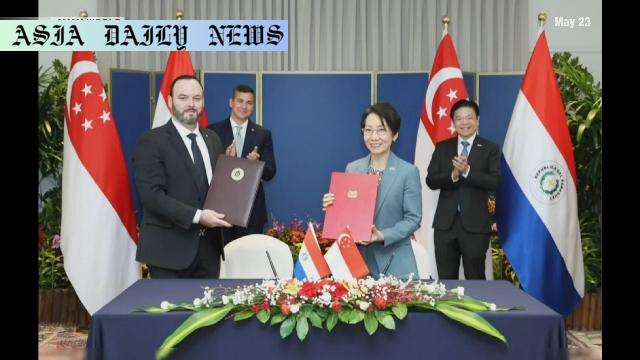Carbon Credits: Singapore collaborates with nations across Asia, South America, and Africa to achieve its 2050 net-zero emissions target.
Singapore aims for net-zero emissions by 2050.
Carbon credits are central to their strategy, achieved through global collaboration.
The country provides technology and funding to help partner nations reduce emissions.
Partnerships have been established with nations like Paraguay, Bhutan, and Rwanda.
Limited space for renewable energy infrastructure fuels their dependency on carbon credit systems.

Singapore’s Commitment to Net-Zero by 2050
Singapore has made bold strides in addressing climate change by committing to achieving net-zero emissions by the year 2050. Despite being a small island nation with limited space for renewable energy infrastructure such as wind turbines and solar farms, Singapore has set itself apart by adopting innovative strategies fueled by global partnerships. Leveraging its strong economic standing and technological expertise, the country is focusing on carbon credits as a viable and impactful tool for decarbonization.
Singapore collaborates with countries across Asia, South America, and Africa to achieve this ambitious goal. The recent agreement signed with Paraguay is a testament to Singapore’s dedication to global cooperation. This partnership marks the seventh such arrangement, joining earlier agreements with countries like Bhutan, Peru, and Rwanda. By offering these nations technological and financial support, Singapore assists them in reducing their emissions. Once these reductions are verified, a portion of the generated carbon credits is transferred to Singapore, bringing the island nation closer to its net-zero ambition.
The Role of Carbon Credits in Tackling Climate Change
Carbon credits play an essential role in the global climate strategy. They are tradable certificates that represent the reduction, removal, or avoidance of one metric ton of carbon dioxide or equivalent greenhouse gases. Singapore’s adoption of this mechanism ensures that its emissions are offset in measurable and verifiable ways, enabling responsible decarbonization. The country’s investments in its partner countries contribute to technological advancements and economic growth in developing regions, creating a win-win situation for all stakeholders.
According to experts, Singapore’s compact geography has made large-scale deployment of green energy infrastructure challenging. Hence, by focusing on carbon credits, Singapore acknowledges its geographical constraints while ensuring that it plays an active and responsible role in global climate efforts. This approach not only helps Singapore meet its commitments but also stands as a powerful model for other nations facing similar challenges.
Integrating Innovation and Sustainability
Another critical aspect of Singapore’s strategy is its aim to integrate this initiative with its broader green business expansion goals. These partnerships extend beyond environmental concerns and have the dual effect of fostering international cooperation while also opening doors to economic opportunities. By introducing green technologies and investing in emission mitigation projects, Singapore positions itself as a leader in green solutions, contributing to the global economy’s transition to sustainable practices.
Moreover, Singapore has consistently advocated for climate-conscious policymaking at international forums, ensuring that its efforts resonate beyond its borders. Industry leaders within the country are also encouraged to align their operations with sustainable practices, significantly reducing domestic emissions while amplifying nationwide climate goals.
Conclusion: A Model for Global Collaboration
Singapore’s journey to achieve net-zero emissions by 2050 demonstrates a unique blend of resolve, innovation, and cooperation. The reliance on carbon credits underscores the importance of global partnerships in addressing challenges posed by limited resources. The agreements with nations like Paraguay, Bhutan, and Rwanda exemplify how collaborative efforts can lead to shared benefits encompassing both environmental and economic gains. As countries worldwide watch Singapore’s progress, its approach can inspire similar initiatives that harmonize environmental responsibility with economic progress.



Commentary
Understanding Singapore’s Strategic Choice
Singapore’s decision to adopt carbon credits as a central strategy for achieving net-zero emissions reflects the complexity of its domestic and global challenges. As a densely populated city-state, it faces unique constraints when it comes to land availability for renewable energy projects. Thus, the use of carbon credits allows it to mitigate emissions effectively while leveraging its strength in global economic relations and technological innovations.
The Importance of Global Collaboration
What stands out in Singapore’s approach is its emphasis on intercontinental cooperation. By working with nations in diverse regions such as Bhutan, Paraguay, and Rwanda, Singapore not only addresses its domestic environmental goals but also strengthens global ties. This collaborative model facilitates shared opportunities for green growth and developmental prosperity, making the fight against climate change a joint endeavor rather than an isolated national effort.
Implications for Other Nations
Singapore’s strategy also raises important lessons for other countries facing similar geographical or resource constraints. Its focus on carbon credit agreements demonstrates that even small nations can make substantial contributions to global environmental goals. Moreover, this approach underscores the imperative for wealthier countries to support developing economies in achieving their climate targets, fostering equitable progress to net-zero emissions worldwide.
Overall, Singapore’s journey offers a luminous example of how challenges can be turned into opportunities. By innovatively addressing its limitations, the country is setting a tone of optimism and responsibility in the global fight against climate change.